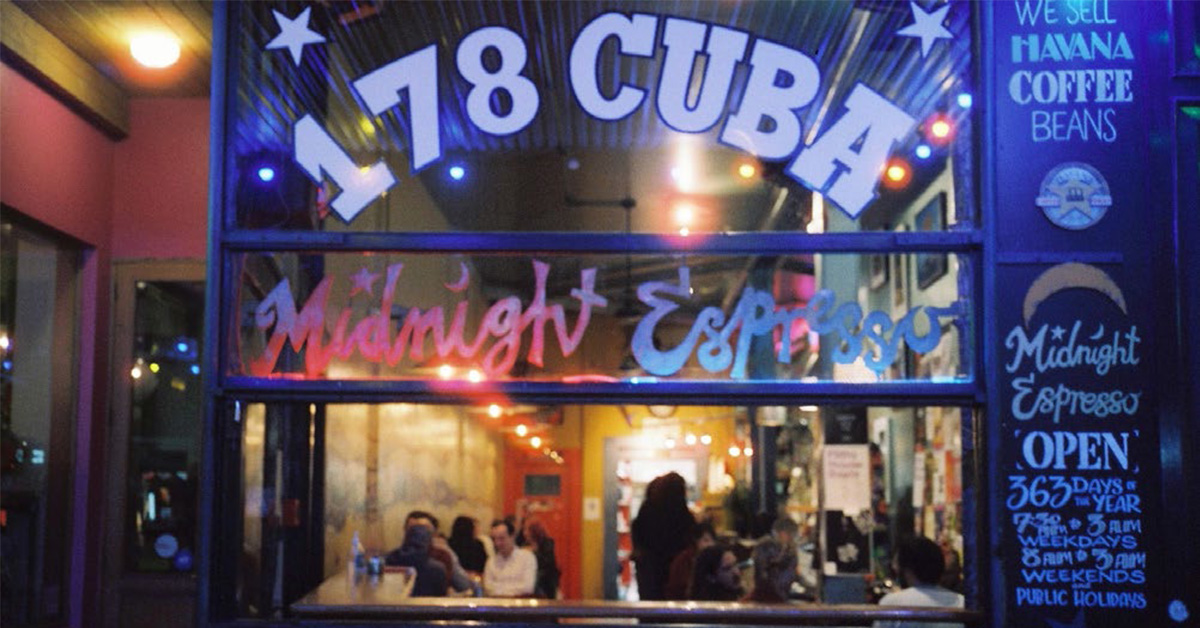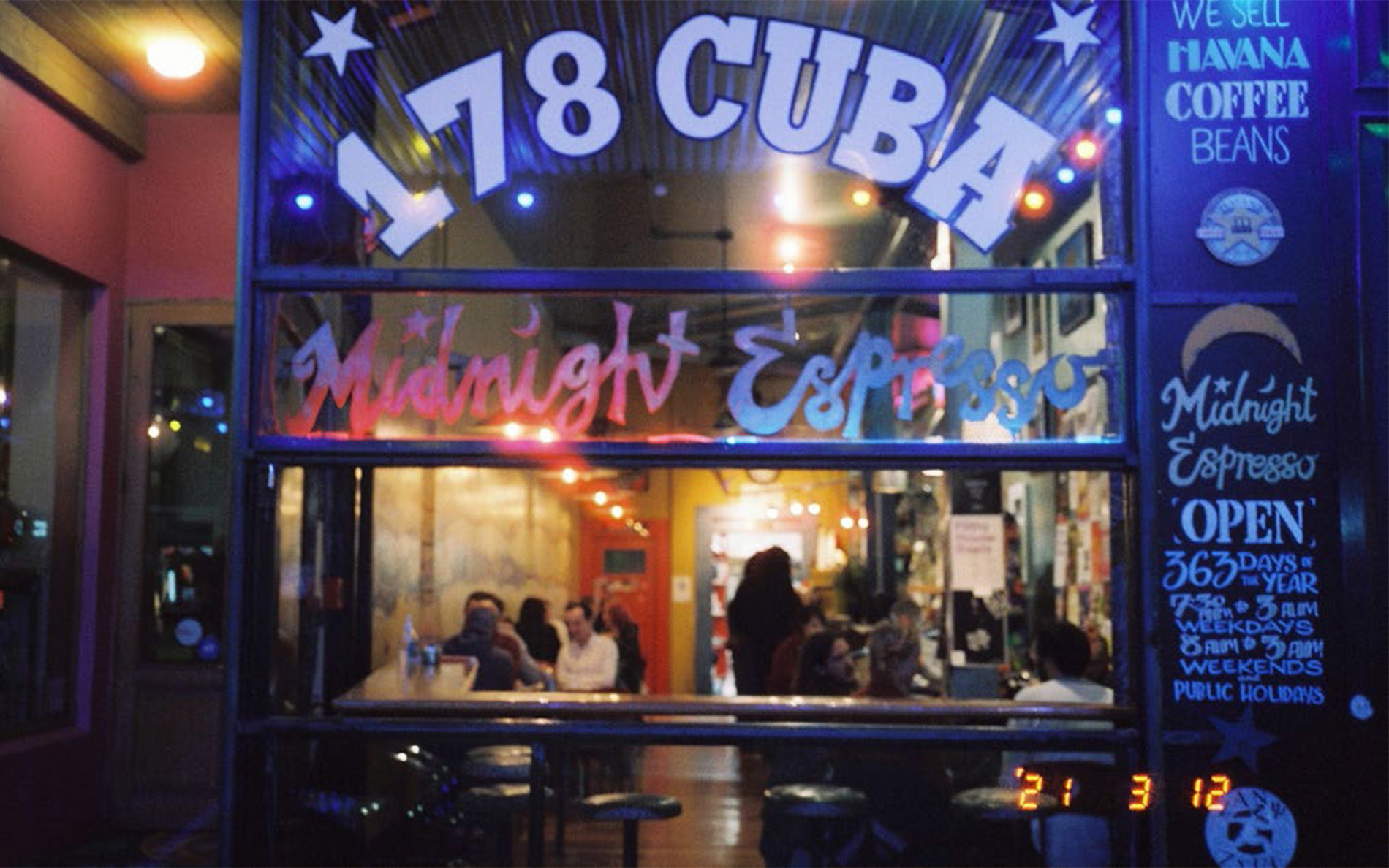
Culture Etc.

Above: Visiting cafés like Midnight Espresso on Cuba St were formative experiences for Tess Nichol — to her, their wonky, artsy aesthetic feels still like the truest version of what a café is “supposed” to be. Photo: Martyn William Pepperell.
To and From
Home towns tend to be missed, then scorned — and finally rediscovered.
By Tess Nichol
When ordering a book online, I would venture to guess that not many of us think it necessary to check the listed dimensions before purchase. It certainly didn’t cross my mind, which is how I ended up with a 21.5 centimetres wide, 25 centimetres high copy of Swann’s Way — the first volume of Marcel Proust’s seven-part novel In Search of Lost Time — sitting on my book case. Strangely square and very thin, my edition of the famous text looks at first glance like a picture book for the world’s most intellectual baby. Inside the typeface is tiny, like a Bible’s, and formatted with two columns per oddly wide page. It is, unfortunately, unreadable.
I had decided I would like to read Proust after coming across a reference to a theory of his in another novel, which I found incredibly moving. The author (I’m pretty sure it was Jonathan Franzen) described how, according to Proust, our earliest memories of objects become the totemic ideal of something — how the daisies you see in your childhood garden, for example, become the truest expression of the idea of flowers, against which every other flower for the rest of your life is measured.
Because I spent three quarters of my life in Wellington, this holds true not only for childhood memories, but for pivotal moments in my young-adult life as well. To me, the idea of a big night out will always recall stumbling down the slippery bricks of Cuba St towards Mighty Mighty at midnight (or Courtney Place at 2am), freezing on a late-December Saturday on the short walk from Southern Cross, the bar at the very top of town. It means always, always bringing a jersey even though you know the chances of leaving it under some sticky bar table are fairly high.
If I’m reading a book set at a university, I picture the hilly layout of Victoria University’s Kelburn campus. The platonic ideal of a café, to me, is one with mismatched crockery, worn out couches and ironically bad art on the walls; one with a community notice board and a general vibe just short of twee. As much as I love today’s café scene, there’s always something jarring about how good every new spot looks now, how expertly designed the spaces are and how the staff are so neatly put together and professional.
I left Wellington about seven years ago, and despite missing it terribly for a good while, at some point I noticed on trips to see my family that I’d started referring to my flight “home” as the one taking me back to Auckland. It was possibly around this time that I began to get a little thrill out of being slightly disdainful about the place I’d lived in for the vast majority of my life.
A recent afternoon stroll in Seatoun involved a gust of wind so forceful that sand ended up in my mouth a good 500 metres from the beach.
There is an earnestness to Wellington’s city culture, a self-seriousness, that is hard to see when you’re in it, and a bit cringeworthy once you’re viewing it with some distance. It’s the kind of place where you are expected to take seriously the idea of a group of public servants gathering together to cross-stitch swear words onto handkerchiefs and call it political. Where you could reasonably expect a flash mob to take place after 2013. A place where the mayor gives the key to the city to a cat. (If Mittens had pulled his little roaming stunts in Auckland he’d have been hit by a car immediately.) A friend and I tend to describe anything we find self-consciously quirky as being “a bit Wellington”. One ex-boyfriend likes to joke it’s the city that thinks it invented coffee.
Being mean about the weather is also fun, I think because Wellingtonians seem to receive any observation of bad weather as a direct personal slight. I am for example reliably informed every time my plane lands in gale-force winds that actually I should have been here yesterday, when the weather was just beautiful. To be fair, the last few times I’ve been down Wellington has turned on the most gorgeous crisp winter days, even if a recent afternoon stroll in Seatoun involved a gust of wind so forceful that sand ended up in my mouth a good 500 metres from the beach.
For a while, I’d find myself bummed out during visits by the stasis of the inner city, the worn-out feeling of Cuba St and Manners Mall, the way everything was basically the same only a bit worse than what I remembered. Walking down Lambton Quay on a quiet and overcast Sunday morning was an exercise in depression. Impossible to please, I then became annoyed when friends started to suggest meeting at some new café or bar I’d never heard of, or if I walked past a shop which used to be an antiques store I had never once been inside and saw that it now sold boutique clothing. Hey, I might have wanted to buy some ancient overpriced furniture from there! I didn’t like that my city was moving on without me.
Maybe it’s because whatever transformation the capital has undertaken away from its overplayed Coolest Little Capital-era is finally bedding in, and the cautious new shape the city is starting to take feels interesting again, but these petty complaints have now mostly fallen away. Although it also occurs to me that missing, then scorning, and finally rediscovering your love for where you’re from is the rough arc of most coming-of-age stories. I’ve also felt more keenly aware since turning 30 that Wellington is where most of my family live. It’s where my baby god-daughter is, and some of my dearest friends. I am jealous when my parents, who live near Zealandia, send pictures to our family group chat of the five kea hanging out in their garden. On my last visit I asked my friend to stop the car so I could take a photo of the south coast, because I wanted to remember how lovely it looked in that moment.
I ended up borrowing a copy of Swann’s Way from the library, and discovered that perhaps my copy’s shape and type size hadn’t been the core issue. I returned it, late, with the library receipt tucked shamefully between pages 10 and 11. I haven’t forgotten that secondhand description of Proust though. I was recently in Wellington for my god-daughter’s naming ceremony, flying in with my partner late on a Friday night. From the back of a taxi I saw the city come into view, street by street, in the exact same order that it had so many times in so many car rides before. The houses were so house-like, the hills so primally recognisable, and I knew exactly how chilly it would feel to stand underneath the cool orange glow of each lamp post. I was 32 and I was 11, experiencing the thrill of being out late enough to see the stars above the city. I was home.
Tess Nichol is North & South’s deputy editor.
This story appeared in the September 2022 issue of North & South.

